In Australia, construction companies have begun building roads from recycled waste, adding to the country’s arsenal of climate adaptation tools. It leads the way in sustainability, generating more solar power than anywhere globally.
Currently, Australia produces eight times the global average of rooftop solar per person. Now, its citizens have something else to feel proud of in the fight against climate change.
The concept of plastic roadways began in 2018 with the local Tasmanian government. It wanted to recycle single-use plastics and other waste cleverly. After some deliberation, they came up with the idea of creating roadways from soft plastics and glass. It’s the first road of its kind in Australia.
The 500-meter (1,640-foot) road outside the city of Hobart consists of around 173,600 plastic bags and packaging. Workers repurposed 82,500 glass bottle equivalents that would’ve otherwise been sent to a landfill as well.
In addition, construction materials included toner from approximately 5,900 used ink cartridges and over 33 tonnes of recycled asphalt. These combined materials created the 330 tonnes of asphalt used for road construction in the town of Snug.
The council decided to build the road to help the environment, Kingborough Councillor Richard Atkinson told Australia’s ABC News. While the product costs more, Atkinson said it would save the council money in the long term. It’s estimated that the road will last fifteen percent longer than a typical asphalt roadway.
Other roads made from recycled waste already exist in other areas of Australia. South of Perth’s business district, the government recently added extra lanes to Western Australia’s Kwinana Highway. This wouldn’t stand out in normal circumstances; however, this stretch of the road consists of untraditional materials.
Australians Reveal How They Can Build Roadways Out of Recycled Waste
Two stabilizing layers beneath the asphalt consist of 25,000 tons of recycled concrete. 90% of these materials were derived from the demolition of a football stadium in Perth.
While Australia sets a great example to the world, roads comprised of recycled waste are still rare. Under the National Waste Policy, federal, state, and territory governments aim to recycle 80% of building and construction materials by 2030. However, currently, only about forty percent of these materials get recycled.
Of the 74 million tons of waste, Australia produced in 2020, about 22.9 million tons consisted of masonry items. Plastics, on the other hand, comprised only 2.5 million tons. Of the 61.5 million tons of waste managed by waste recovery companies, 44% came from construction materials. Meanwhile, households and local governments contributed only 20% of waste.
Much of the concrete, steel, timber, asphalt, concrete, drywall and other materials could become recycled waste. Unfortunately, the majority sits in landfills because of economic policies. It costs less to buy new items and throw them out compared to reusing or recycling them.
While this practice makes companies more profitable, it robs the Earth and its inhabitants. People and ecosystems end up paying a high price for our economy centered around limitless growth. However, you can’t have infinite profits on a finite planet. That’s where a circular economy would come into play–making entirely new products from recycled waste,
Methods to Reduce Carbon Footprint from Construction
As construction and building activities account for 40% of greenhouse gas emissions, it’s vital to enforce more sustainable policies. The United Nation’s International Resource Panel found that countries could reduce these emissions through several significant avenues.
Martina Otto, the head of UNEP’s Cities Unit, cites the following strategies for slashing emissions in the construction industry:
- Sustainably managing and harvesting timber. This action could reduce carbon emissions by between one to eight percent in G7 nations by 2050.
- Designing buildings using fewer materials. This change could save eight to ten percent of emissions by 2050.
- Consider passive cooling and heating, along with natural light. Reducing energy use in this way would lower the carbon footprint of buildings.
- Construct buildings using sustainable products. For example, a 2020 study found that agro-wastes such as sugarcane bagasse, rice husk ash, and bamboo leaves could bolster construction processes. The study found that these materials boost durability, reduce costs and improve sustainability.
According to the panel’s models, eco-friendly practices could reduce emissions from residential building construction in the G7 nations and China by at least 80% in 2050. They estimate it would slash emissions by 50-70% in India.
Other Countries Building Roads from Recycled Waste
It’s not just Australia that’s hopping on the plastic road bandwagon. Countries such as India, Mexico, the Philippines, Ghana, the United States, and the United Kingdom have adopted them also. In fact, the first plastic roadway appeared in India about twenty years ago. About 60,000 miles of roads have been constructed from recycled waste.
In Ghana, only 23% of roads are paved, so there’s a huge opportunity for development in the small country. In 2018, Ghanian President Akufo-Addo announced the ambitious plan of creating a completely circular economy by 2030. Then, much of the 1.1 million tons of plastic produced each year could serve as material for paving roads.
By diverting waste before it enters landfills, it reduces the amount of plastic pollution in the environment. Expanding roadways in Ghana using green technology would create jobs and boost the economy. It’s a win-win for both people and the planet.
Final Thoughts on How Countries Are Building Roads Out of Recycled Waste
Countries like Australia, India, and Ghana have proven the old saying that one man’s trash is another’s treasure. In this case, they’ve used recycled waste to build roads, helping to reduce emissions. Laying asphalt for roadways and other construction activities contributes about forty percent of yearly carbon emissions worldwide.
However, using already existing materials to construct roads significantly reduces emissions since no production or manufacturing is required. The only emissions would come from machines used to lay the asphalt. Hopefully, more countries around the globe will follow suit and build roads with recycled waste. This collective effort would mark a massive step in beating climate change.
















 Community
Community

